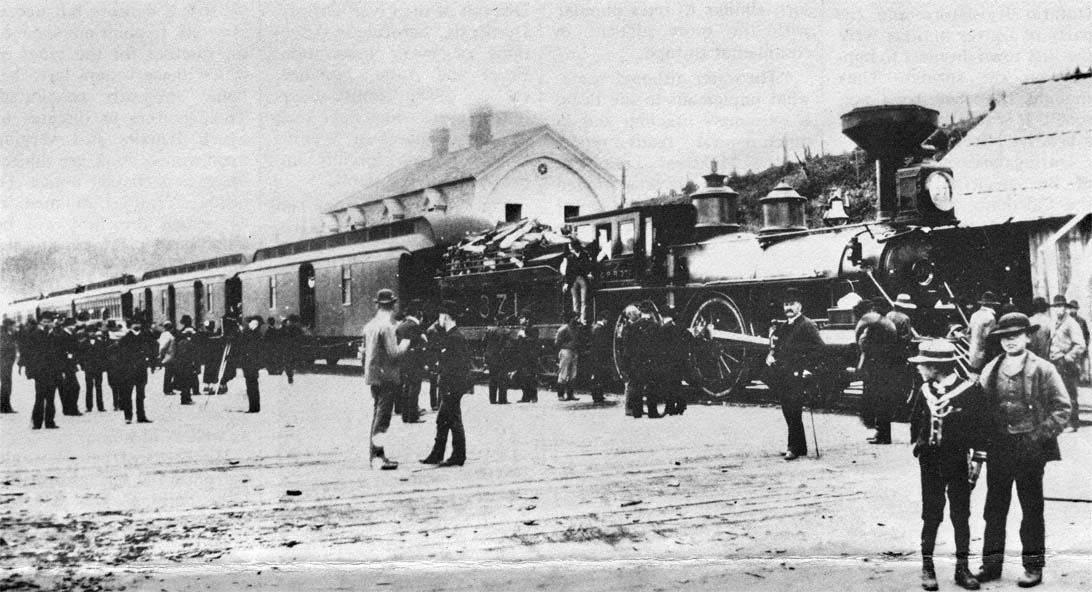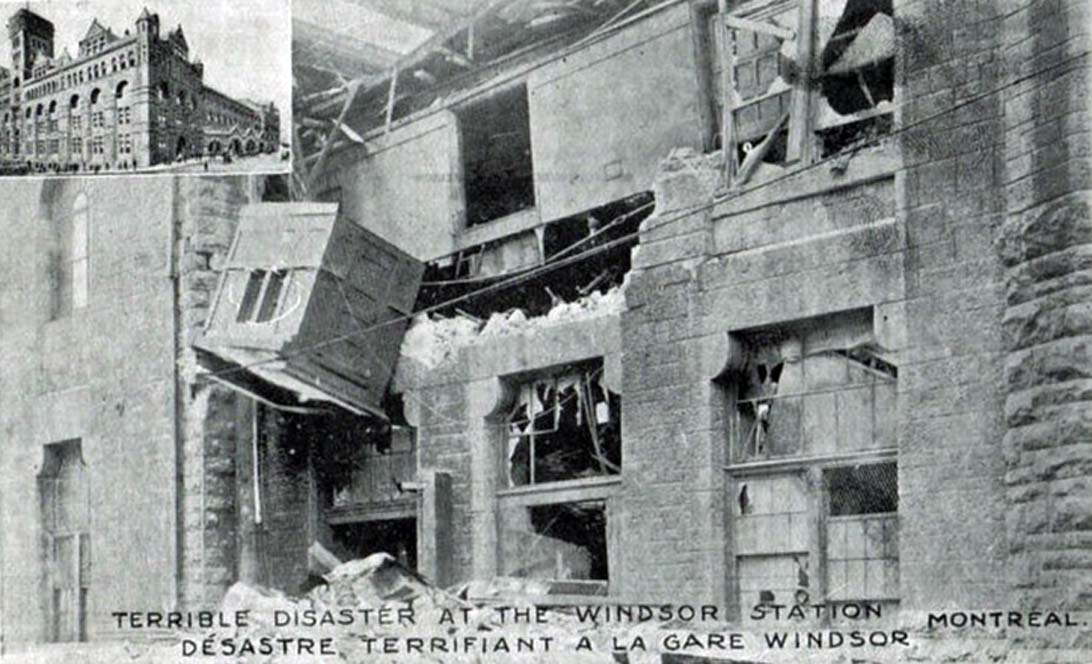
|
VOLUME XI
NUMBER 2 |
FEBRUARY 16, 1981 CENTENNIAL ISSUE
|
|

With "Eclat" the Occasion Deserved
By Patrick Finn
MONTREAL - Most Canadians have heard all about the driving of the Last Spike by Sir Donald Smith, but few have heard much, if anything, about the first regular passenger train to cross the nation.
The event and the ceremonies that took place at the departure point and along the route could be categorized as more of a public occasion than that grand company event, the last spike ceremony at Craigellachie, B.C. on 7 Nov 1885.
Called the "Pacific Express", the first transcontinental train left Montreal's Dalhousie Square Station (later Place Viger) at 20:00, Monday, 28 Jun 1886, and arrived at Port Moody, B.C. at noon, 4 Jul 1886.
Allowing for the time zone differential, the first train took five days and 19 hours to travel about 2,900 miles to Port Moody. The community served as the west coast terminus of the Canadian Pacific Railway until the company extended the main line 12.2 miles to Vancouver in 1887.
(The first passenger train for the east left Port Moody on 6 Jul 1886, arriving in Montreal on Monday, 12 Jul 1886.)
A check of Montreal newspapers reporting the gala departure of the first westbound train reveals that there were 72 passengers on board, not counting immigrants.
A story in The Montreal Star under the heading "All Aboard for the Pacific" notes that William Van Horne, Canadian Pacific's vice-president and general manager at the time, had his private business car temporarily attached to the train.
As part of the ceremony, the Saskatchewan took Montreal Mayor Honore Beaugrand and other dignitaries as far as St. Martin's Junction, 12.8 miles from the departure point.
The first class sleeping car on the first train was the Honolulu, which has a private stateroom and bath in addition to the usual open sofa sections.
The dining car was the Holyrood, which carried $3,000 worth of silverwear. (Only the Honolulu and the baggage car made the full trip.)
The Montreal Field Battery fired the send-off salute, with the Victoria Rifles adding their own touch of military formality to the occasion.
The newspaper story observes that the train left "with the eclat (brightness) that the occasion deserves," but adds that the intention of making the national voyage "a grand affair", had been abandoned, the trip was to be "purely a business one".
"The ceremonies of dispatching the first train to the Pacific were not imposing, but the train started on time and everything was conducted on strictly business principles, for which the CPR has become famous," the story said.
"At 20 hours sharp, his worship the mayor gave the signal to start, and the engine with its 10 cars steamed out of the depot amidst the salvos of the field battery and the cheers of spectators."
The first train arrived in Ottawa at 23:35, at North Bay at 09:10, and at Port Arthur, Ontario, (Thunder Bay) at 16:00, according to an updated report in the next day's paper.
Transcontinental trains continued to operate from Canadian Pacific Stations in Montreal for 92 years, until VIA Rail Canada took over the service and shifted Montreal departures for Vancouver to Canadian National's Central Station.
The last train to leave Windsor Station for Vancouver departed on 28 Oct 1978.
The railway opened Windsor Station to trains on 4 Feb 1889, but the transcontinental CPR trains continued to depart from the station at Place Viger until 1892.
Then for a short time trains ran out of both stations and merged some distance down the line. In total, transcontinental trains ran out of Windsor Station for 86 years.
Probably the most spectacular event in the history of the Windsor Station was the great accident of 17 Mar 1909, when a Boston express barrelled into the station at 50 mph, crashing through the granite walls of the building, killing five persons, and injuring 24.
Station master Thomas Whelan risked his life to clear passengers from the end of the track and prevented further fatalities.
All Montreal papers carried front page stories on the wreck, some with photos and others with drawings of the engines and cars crumpled in a heap at the end of Donegana Street.
 and is reprinted here with their permission.
All photographs, logos, and trademarks are the property of the Canadian Pacific Railway Company.
and is reprinted here with their permission.
All photographs, logos, and trademarks are the property of the Canadian Pacific Railway Company.By Omer S.A. Lavallee - 1959
It will be fifty years, on St. Patrick's Day, 1959, since a runaway train violated the passenger precincts of Montreal's Windsor Station, bringing death to five people.
This is the only major accident which has happened in the seventy years during which the Canadian Pacific's station and headquarters has been open to the public, but because of the mysterious and spectacular aspects of this incident, it is a tale which has been told and retold among railway personnel in the Montreal area. Many retired men can recall the events clearly to mind, the fireman on the ill-fated train died a natural death as recently as September 1958, and one of the Association's associate members, Mr. John E. Tinkler, of Hudson, Quebec, a retired CPR mechanical man, recalls the day of the accident as if it were yesterday.
The train was the overnight Boston-Montreal run No. 12, consisting of engine 902, a 4-6-0 built by North British in 1903, a baggage car, two passenger cars, and a sleeping car. It was in charge of Conductor Arthur H. Harvey when it left Newport at 04:55, 17 Mar 1909, due in Montreal at 08:30. The engineman in charge of No. 902 was Mark Cunningham, his fireman was Louis Craig. Joseph E. Pelletier was the baggageman, and Joseph A. Dion was the trainman. The trip proceeded uneventfully toward Montreal, the train making its customary stop at Montreal Junction, now known as Montreal West.
Leaving Montreal West, Conductor Harvey gave his engineer the communicating signal which corresponded to the present signal 16(d), "stop at the next station", as he had a passenger to descend at Westmount, also as prescribed by the rules, but it was after this acknowledgement was made that the prime event occurred which led directly to the accident.
According to the testimony of the fireman at the coroner's inquest, somewhere between Montreal Junction and Westmount, a plug blew on the boiler on the fireman's side, frightening him and filling the cab with live steam. He responded instantly to his initial reaction to jump, thinking that the boiler was about to explode. Landing in a snow bank, he was unhurt, suffering only a few bruises. The train rolled by him on its way to Westmount, the passengers and crew completely unaware of what had happened. Only when the train failed to stop at Westmount, was any concern manifested. The Conductor attributed the failure to stop to the engineer having forgotten to do so (Westmount was only a conditional stop in those days) and decided to allow him to go into Windsor Station, which the passenger who had wished to descend was agreeable to.
While accounts in the possession of the writer do not give exact details, it is apparent that Engineer Cunningham finally left the engine, after trying unsuccessfully to stop it, somewhere after passing Westmount Station. The train continued until, with the speed still un-checked passing over the Guy Street interlocking, one of the trainmen suspected that the engine was out of control and pulled the emergency cord. This had the effect of checking the speed seriously, indeed with such a shock that the passengers were shaken up considerably, and the sleeping car porter, caught unawares, perhaps making up his berths, was thrown halfway along the aisle of the car.
While the speed of the rain was established to have been between 35 and 40 miles per hour just before the emergency brakes were applied, nonetheless the momentum carried it into the station, through the buffer stop, across the concourse, through the walls separating the concourse from the ladies' waiting room, finally stopping in that room. The engine remained almost upright, leaning against one of the pillars supporting the ceiling. The tender sank part way through the floor into the vaults, while the baggage car jackknifed and broke through the glass and metal latticework which screened off the south end of the concourse overlooking Donegana Street (the westward extension of Lagauchetiere Street). The station at that time consisted only of five tracks, with the fifth track on the south side parallel to Donegana Street.
The death toll was tragic. Killed were Mrs. W.J. Nixon of Ash Avenue, Verdun, and her two children, Marjorie and Ross. Another child, Elsie Villiers, who was also in the waiting room at the time, also died in the accident. The fifth victim was Mark Cunningham, the engineer, who suffered a fractured skull when he jumped from the runaway engine sometime after Fireman Craig. Both were picked up by the Point Fortune local train which followed the Boston train into the station, but Cunningham never regained consciousness, and he died the day after the accident.
The case of the Nixon family was a particularly pitiful one. Mrs. Nixon and her two children were at the station to wait the return of Mr. Nixon, a train dispatcher at Medicine Hat, who was due in on the transcontinental train some time later. When Nixon did arrive, he saw the accident, but hastened home to Ash Avenue to see his family. Being told by neighbours that his wife and children had gone to the station to meet him, he returned to Windsor Station only to find out the worst.
Several days were required to remove the engine, tender, and baggage car from the building. Building engineers were profuse in their admiration for the structure of the building which could stand the shock and remain structurally sound. The Passenger Department occupied the floor above the waiting room where many of the pillars were knocked out by the careening engine. One can picture the consternation in this department when the crash came and the floor suddenly sagged dangerously. Among the injured was a clerk in the office of the CPR special police service, who occupied offices in the vault below the concourse. He was trapped for two hours by broken building beams, but was extricated without serious injury. Thomas Whelan, a gateman who later became Stationmaster, showed great presence of mind, in getting passengers who were clustered around the end of the track awaiting the train, out of the way when it became obvious that the train was not going to stop. The contrasts were striking. The wreckage of the engine, tender, and the baggage car necessitated the dismantling of these units to remove them, the passenger cars didn't leave the tracks nor was a pane of glass broken in them.

An Investigation headed by Mr. D. McNicoll of the Canadian Pacific Railway, revealed that a washout plug blew out on the fireman's side of the engine. Why the cab would fill with steam remains a mystery as the plug would be below, and outside of the cab. All of the boiler staybolts appeared to be intact. The only person who might have been able to shed more details on this tragic accident, the engineer, was never able to give testimony before he died.
Fireman Craig, who, in and interview with a newspaper reporter, expressed fear that he would lose his job, remained with the company, becoming an engineer and retiring in April 1953. He died only six months ago. Engine 902 was taken to Angus Shops and repaired. As No. 2102, class E5e, it was finally scrapped in 1938.
